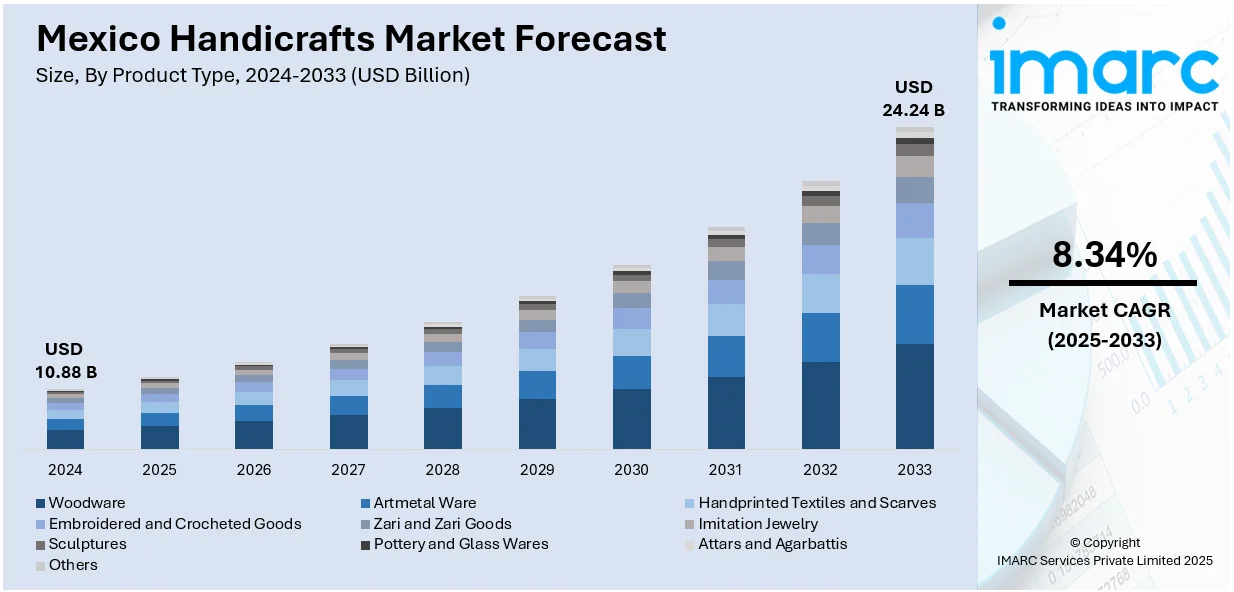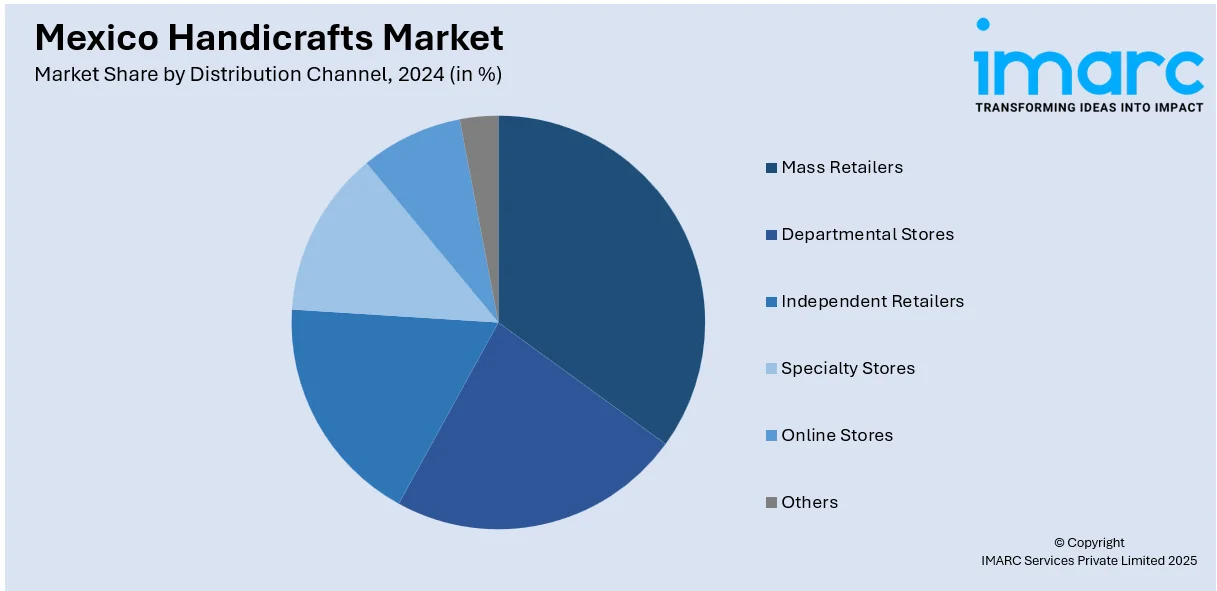
Mexico Handicrafts Market Size, Share, Trends and Forecast by Product Type, Distribution Channel, End Use, and Region, 2025-2033
Mexico Handicrafts Market Overview:
The Mexico handicrafts market size reached USD 10.88 Billion in 2024. Looking forward, the market is projected to reach USD 24.24 Billion by 2033, exhibiting a growth rate (CAGR) of 8.34% during 2025-2033. The market is driven by factors such as the increasing demand for traditional and locally produced items, growing consumer interest in sustainable and eco-friendly products, and the expanding influence of digital platforms that enable artisans to reach global audiences. Additionally, government initiatives to promote cultural heritage further boost the Mexico handicrafts market share.
|
Report Attribute
|
Key Statistics
|
|---|---|
|
Base Year
|
2024
|
|
Forecast Years
|
2025-2033
|
|
Historical Years
|
2019-2024
|
| Market Size in 2024 | USD 10.88 Billion |
| Market Forecast in 2033 | USD 24.24 Billion |
| Market Growth Rate 2025-2033 | 8.34% |
Mexico Handicrafts Market Trends:
E-Commerce Expansion and Digital Platforms
The growth of Mexico's handicrafts industry has been significantly supported by online platforms, where small businesses and artisans increasingly utilize e-commerce to sell and promote their products. Most Mexican artisans transitioned from street markets to online marketplaces such as Etsy, Amazon, and their websites due to the expansion of global e-commerce giants. For example, Amazon Handmade's "Made in Mexico" storefront sells more than 130,000 handmade products made by over 3,000 Mexican artisans. Approximately 12% of these products highlight traditional crafts in textiles, ceramics, wood, and jewelry. The program seeks to increase the profile of local artisans both globally and in Mexico. The artisans that participate get free storefronts with no fee every month. With a 278% increase in artisan sales, according to reports, the site indicates a growing worldwide demand for genuine, handcrafted items. Through this transformation, they have been able to reach international markets, expanding their base and increasing their profile. Communications between craftspeople and consumers have also been simplified by social networking sites such as Facebook and Instagram. The market space of Mexico Handicrafts has expanded considerably with the help of these online portals, especially among young consumers who appreciate the convenience of online shopping for unique, handmade products.

To get more information on this market, Request Sample
Government Support and Cultural Heritage Preservation
In Mexico, local handicrafts are being embraced in luxury interiors, with designers integrating traditional artisan-made décor into high-end projects. Influenced by regional materials, designers like Cristina Grappin and Ezequiel Farca are incorporating items such as handcrafted ceramics, textiles, and woodwork. This blend of contemporary design and Mexican craftsmanship is gaining popularity, appealing to both local and international clients. The use of these authentic materials brings warmth and cultural identity to upscale homes, creating a unique aesthetic while promoting sustainability and artisan recognition. Moreover, government initiatives in Mexico have significantly contributed to the Mexico handicrafts market growth. Through various programs aimed at preserving cultural heritage, the Mexican government has supported artisans by providing grants, training, and opportunities for exposure. This has helped promote traditional craftsmanship techniques such as weaving, pottery, and embroidery. Cultural festivals and exhibitions, such as the National Handicrafts Fair, have allowed artisans to showcase their work, attracting both national and international buyers. The government’s commitment to preserving these artisanal practices not only helps artisans maintain their livelihoods but also ensures that traditional Mexican craftsmanship continues to thrive.
Mexico Handicrafts Market Segmentation:
IMARC Group provides an analysis of the key trends in each segment of the market, along with forecasts at the region/country level for 2025-2033. Our report has categorized the market based on product type, distribution channel, and end use.
Product Type Insights:
- Woodware
- Artmetal Ware
- Handprinted Textiles and Scarves
- Embroidered and Crocheted Goods
- Zari and Zari Goods
- Imitation Jewelry
- Sculptures
- Pottery and Glass Wares
- Attars and Agarbattis
- Others
The report has provided a detailed breakup and analysis of the market based on the product type. This includes woodware, artmetal ware, handprinted textiles and scarves, embroidered and crocheted goods, zari and zari goods, imitation jewelry, sculptures, pottery and glass wares, attars and agarbattis, and others.
Distribution Channel Insights:

- Mass Retailers
- Departmental Stores
- Independent Retailers
- Specialty Stores
- Online Stores
- Others
A detailed breakup and analysis of the market based on the distribution channel have also been provided in the report. This includes mass retailers, departmental stores, independent retailers, specialty stores, online stores, and others.
End Use Insights:
- Residential
- Commercial
The report has provided a detailed breakup and analysis of the market based on the end use. This includes residential and commercial.
Regional Insights:
- Northern Mexico
- Central Mexico
- Southern Mexico
- Others
The report has also provided a comprehensive analysis of all the major regional markets, which include Northern Mexico, Central Mexico, Southern Mexico, and others.
Competitive Landscape:
The market research report has also provided a comprehensive analysis of the competitive landscape. Competitive analysis such as market structure, key player positioning, top winning strategies, competitive dashboard, and company evaluation quadrant has been covered in the report. Also, detailed profiles of all major companies have been provided.
Mexico Handicrafts Market News:
- In September 2024, the Mexican startup, Someone Somewhere, integrated AI with traditional artisan crafts, empowering rural communities and preserving cultural heritage. This innovative model connects artisans to global markets, ensuring fair compensation and economic inclusion. AI-assisted designs have expanded their reach, leading to collaborations with top brands like adidas, elevating Mexican craftsmanship globally.
Mexico Handicrafts Market Report Coverage:
| Report Features | Details |
|---|---|
| Base Year of the Analysis | 2024 |
| Historical Period | 2019-2024 |
| Forecast Period | 2025-2033 |
| Units | Billion USD |
| Scope of the Report |
Exploration of Historical Trends and Market Outlook, Industry Catalysts and Challenges, Segment-Wise Historical and Future Market Assessment:
|
| Product Types Covered | Woodware, Artmetal Ware, Handprinted Textiles and Scarves, Embroidered and Crocheted Goods, Zari and Zari Goods, Imitation Jewelry, Sculptures, Pottery and Glass Wares, Attars and Agarbattis, Others |
| Distribution Channels Covered | Mass Retailers, Departmental Stores, Independent Retailers, Specialty Stores, Online Stores, Others |
| End Uses Covered | Residential, Commercial |
| Regions Covered | Northern Mexico, Central Mexico, Southern Mexico, Others |
| Customization Scope | 10% Free Customization |
| Post-Sale Analyst Support | 10-12 Weeks |
| Delivery Format | PDF and Excel through Email (We can also provide the editable version of the report in PPT/Word format on special request) |
Key Questions Answered in This Report:
- How has the Mexico handicrafts market performed so far and how will it perform in the coming years?
- What is the breakup of the Mexico handicrafts market on the basis of product type?
- What is the breakup of the Mexico handicrafts market on the basis of distribution channel?
- What is the breakup of the Mexico handicrafts market on the basis of end use?
- What is the breakup of the Mexico handicrafts market on the basis of region?
- What are the various stages in the value chain of the Mexico handicrafts market?
- What are the key driving factors and challenges in the Mexico handicrafts market?
- What is the structure of the Mexico handicrafts market and who are the key players?
- What is the degree of competition in the Mexico handicrafts market?
Key Benefits for Stakeholders:
- IMARC’s industry report offers a comprehensive quantitative analysis of various market segments, historical and current market trends, market forecasts, and dynamics of the Mexico handicrafts market from 2019-2033.
- The research report provides the latest information on the market drivers, challenges, and opportunities in the Mexico handicrafts market.
- Porter's five forces analysis assist stakeholders in assessing the impact of new entrants, competitive rivalry, supplier power, buyer power, and the threat of substitution. It helps stakeholders to analyze the level of competition within the Mexico handicrafts industry and its attractiveness.
- Competitive landscape allows stakeholders to understand their competitive environment and provides an insight into the current positions of key players in the market.
Need more help?
- Speak to our experienced analysts for insights on the current market scenarios.
- Include additional segments and countries to customize the report as per your requirement.
- Gain an unparalleled competitive advantage in your domain by understanding how to utilize the report and positively impacting your operations and revenue.
- For further assistance, please connect with our analysts.
 Request Customization
Request Customization
 Speak to an Analyst
Speak to an Analyst
 Request Brochure
Request Brochure
 Inquire Before Buying
Inquire Before Buying




.webp)




.webp)












